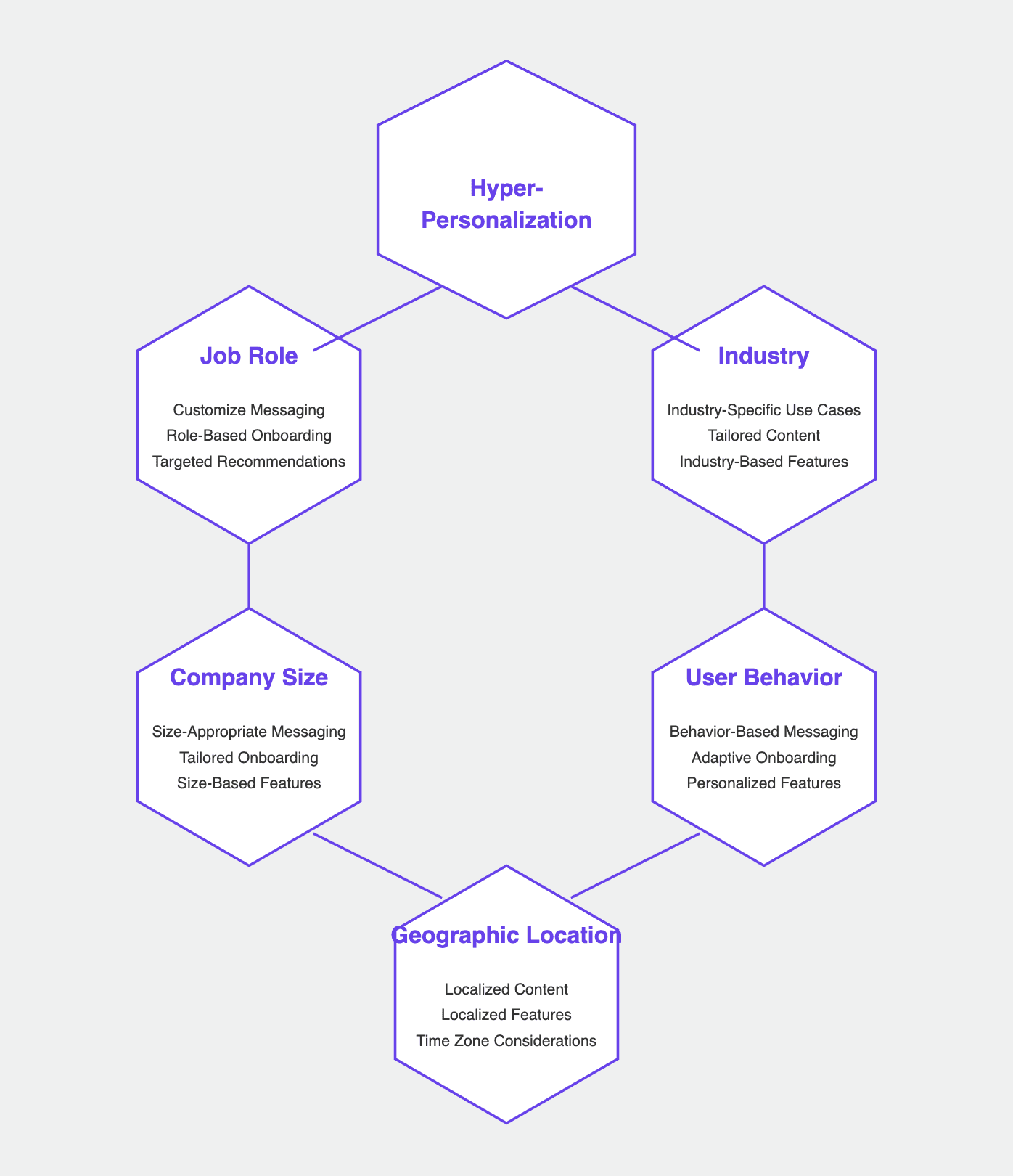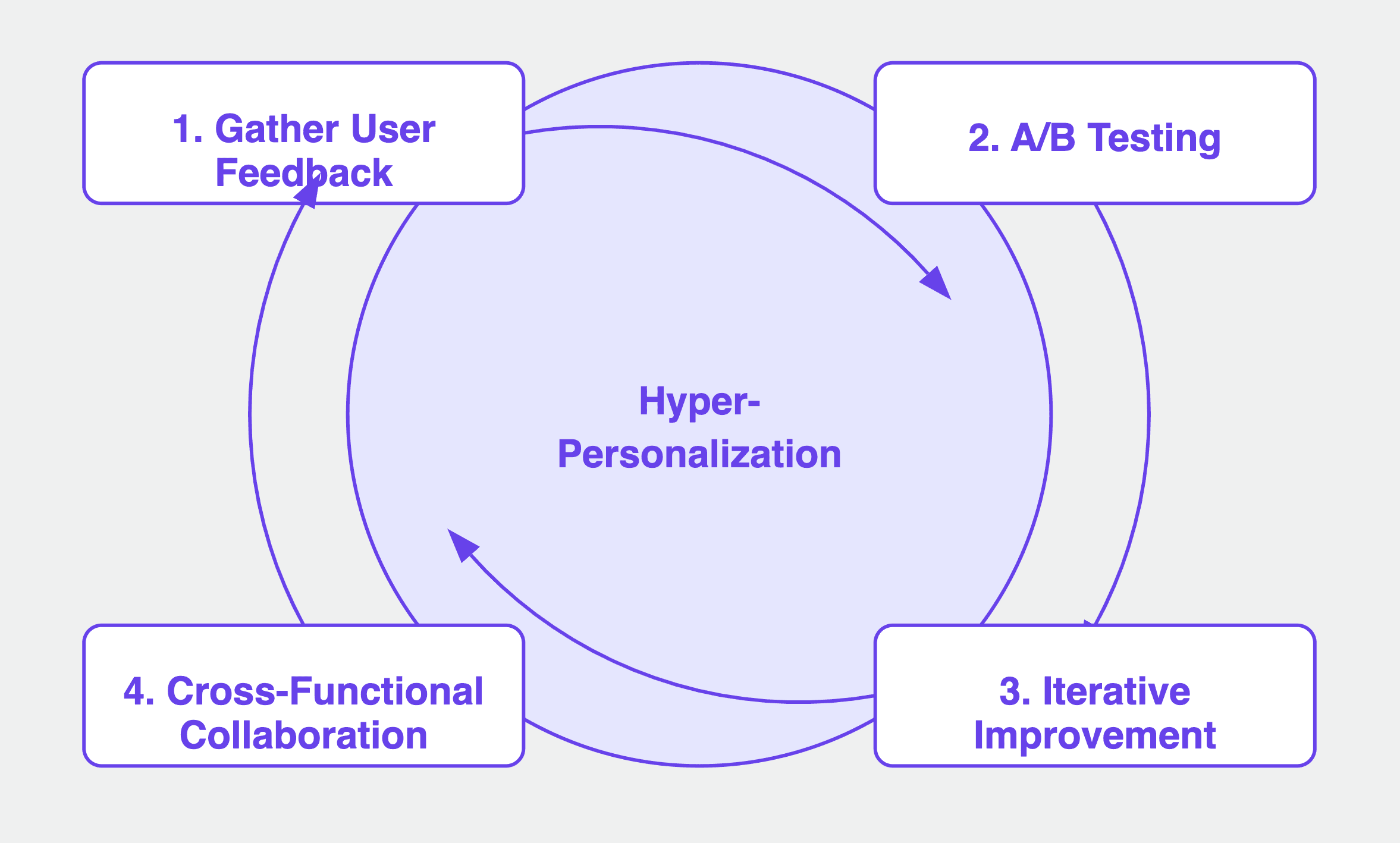
Hyper-Personalization in PLG SaaS: Boost Activation Rates

by
Aleksa Mitrovic
Sep 24, 2024
Identify and convert your most valuable users
Sign Up
Enhancing activation rates is a critical objective. Activation rates, which measure the percentage of users who achieve the intended value from your product, can significantly impact your business growth and customer retention.
This comprehensive guide will explore how hyper-personalization can dramatically improve activation rates by tailoring user experiences based on various data points, with departmental affiliation serving as just one example.
The Importance of Hyper-Personalization
Hyper-personalization goes beyond basic customization. It involves using multiple data points to create a highly tailored and relevant experience for each user. By making your product more pertinent to individual users, you can increase engagement, improve activation rates, and foster long-term customer loyalty.
Data Points for Personalization

Departmental affiliation is just one example of a data point that can be used for personalization. Here are several other data points you can leverage to create a hyper-personalized user experience:
Job Role: Understanding a user's specific job role can help you tailor the experience to their unique needs and responsibilities. For example, a product manager and a product designer may both be part of the product department, but their roles and priorities differ significantly.
Industry: Users from different industries may have varying use cases and pain points. By personalizing the experience based on industry, you can highlight the most relevant features and use cases for each user.
Company Size: The needs and resources of users can vary greatly depending on the size of their company. Personalizing the experience based on company size can help you cater to the unique requirements of each segment.
User Behavior: Analyzing user behavior within your app can provide valuable insights into their interests and priorities. By personalizing the experience based on user behavior, you can surface the most relevant features and content for each user.
Geographic Location: Users from different regions may have varying preferences, regulations, and use cases. Personalizing the experience based on geographic location can help you cater to these regional differences.
Technological Maturity: Users may have different levels of technological maturity, which can impact their needs and preferences. Personalizing the experience based on technological maturity can help you provide the right level of support and guidance for each user.
Collecting and Utilizing Data Points

To implement hyper-personalization, you first need to collect relevant data points. Here are some methods for gathering this data:
1. Onboarding Questions
Ask users a series of questions during the onboarding process to gather relevant data points. This can include questions about their job role, industry, company size, and more. Be mindful of the length of your onboarding survey to avoid overwhelming users.
2. Data Enrichment
Use data enrichment services to gather additional information about your users. These services can provide valuable insights, such as industry, company size, and technological maturity, without requiring users to input the data manually.
3. Integrations
If your SaaS product integrates with other tools, you may be able to gather relevant data points from those platforms. For example, you could collect information about a user's job role or industry from their LinkedIn profile if they choose to connect it.
4. In-App Behavior Tracking
Track user behavior within your app to gain insights into their interests and preferences. This can include monitoring which features they use, how they interact with your product, and what content they engage with.
Implementing Hyper-Personalization

Once you have collected relevant data points, you can use them to create a hyper-personalized user experience. Here's how you can implement personalization based on different data points:
Job Role
Customize Messaging: Tailor your in-app messages and emails to highlight features and use cases that are particularly relevant to the user's job role.
Role-Based Onboarding: Adjust the onboarding process to walk users through features and workflows that are most pertinent to their job role.
Targeted Feature Recommendations: Surface features and tools that are most relevant to the user's job role, helping them discover valuable functionality more quickly.
Industry
Industry-Specific Use Cases: Highlight use cases and success stories that are relevant to the user's industry, helping them understand how your product can address their unique pain points.
Tailored Content: Provide industry-specific content, such as blog posts, webinars, and case studies, to educate and engage users.
Industry-Based Feature Recommendations: Surface features and tools that are particularly useful for the user's industry, guiding them towards the most relevant functionality.
Company Size
Size-Appropriate Messaging: Tailor your messaging to address the unique needs and resources of different company sizes. For example, you might emphasize scalability for enterprise users or affordability for small businesses.
Tailored Onboarding: Adjust the onboarding process to cater to the specific requirements of different company sizes. This could involve showing enterprise users how to set up advanced features or guiding small business users through the basics.
Size-Based Feature Recommendations: Surface features and tools that are most relevant to the user's company size, helping them discover the functionality that best suits their needs.
User Behavior
Behavior-Based Messaging: Tailor your in-app messages and emails based on the user's behavior, providing them with relevant tips, guidance, and feature recommendations.
Adaptive Onboarding: Adjust the onboarding process in real-time based on the user's behavior, surfacing the most relevant features and workflows as they interact with your product.
Personalized Feature Recommendations: Use the user's behavior to surface features and tools that are most relevant to their interests and priorities.
Geographic Location
Localized Content: Provide content that is tailored to the user's geographic location, such as region-specific use cases, success stories, and regulatory information.
Localized Feature Recommendations: Surface features and tools that are most relevant to the user's geographic location, helping them discover functionality that addresses their regional needs.
Time Zone Considerations: Adapt your messaging and notifications to the user's time zone, ensuring that communications are sent at appropriate times.
Technological Maturity
Maturity-Appropriate Messaging: Tailor your messaging to address the user's level of technological maturity, providing them with relevant guidance and support.
Tailored Onboarding: Adjust the onboarding process to cater to the user's technological maturity, offering more detailed guidance for less tech-savvy users or advanced tips for more experienced users.
Maturity-Based Feature Recommendations: Surface features and tools that are most relevant to the user's level of technological maturity, helping them discover functionality that suits their skill level.
Continuous Improvement and Optimization

Hyper-personalization is an ongoing process that requires continuous improvement and optimization. Here are some best practices to help you refine your approach:
Gather User Feedback
Regularly collect user feedback to understand their needs, preferences, and pain points better. This can be done through in-app surveys, interviews, or feedback forms. Use this feedback to inform your personalization efforts and make data-driven decisions.
A/B Testing
Conduct A/B tests to compare the performance of different personalization strategies. By testing various approaches, you can identify what works best for your users and optimize your personalization efforts accordingly.
Iterative Improvement
Continuously analyze user data and iterate on your personalization strategies. As your user base grows and evolves, so should your approach to hyper-personalization. Stay agile and adapt your strategies based on user feedback, data insights, and market trends.
Cross-Functional Collaboration
Work closely with different teams, including product, marketing, sales, and customer success, to align your personalization efforts. By collaborating across functions, you can create a more cohesive and effective hyper-personalization strategy that resonates with users throughout their journey.
Conclusion
In the competitive world of PLG SaaS, hyper-personalization is a powerful strategy for boosting activation rates and driving business growth. By tailoring the user experience based on various data points, you can create a more relevant, engaging, and valuable product for each user.
Remember, hyper-personalization is not a one-size-fits-all approach. It requires a deep understanding of your users, continuous data collection and analysis, and a commitment to ongoing improvement. By embracing hyper-personalization and staying user-centric, you can build a product that truly resonates with your users and sets your business apart from the competition.
As you embark on your hyper-personalization journey, keep in mind that the ultimate goal is to create a product that feels tailor-made for each user. By doing so, you'll not only improve activation rates but also foster long-term customer loyalty and advocacy. In a crowded market, a personalized approach can make all the difference.




